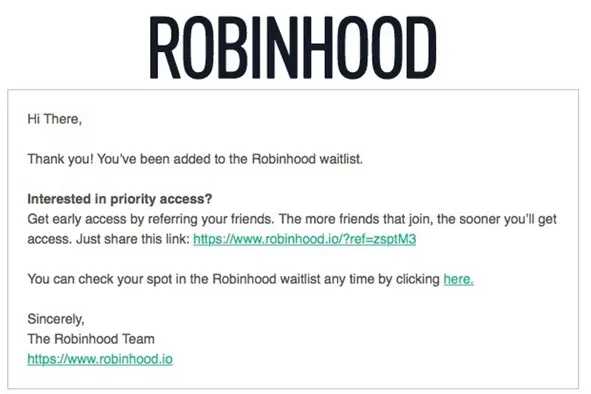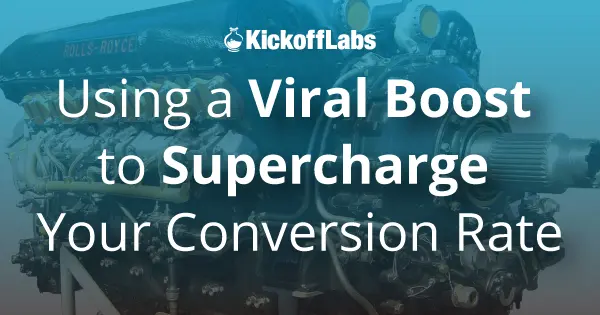
What if your campaign converted at 50%? Would that have a meaningful impact on your business? Of course it would. And it’s not hard. Check out what a recent KickoffLabs customer had to say recently…
_“…I got a 50% conversion rate on my landing page using social referrals. After 2.5 weeks of having my site up here’s what the stats look like:
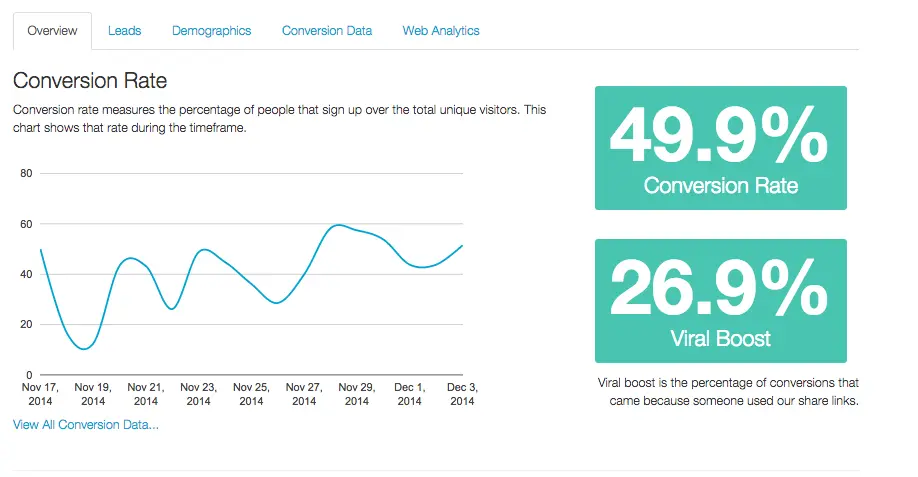
They are not alone. Anyone can follow the best practices they used. In fact there have already been several hugely successful campaigns that were built to encourage social referrals and get their own “Viral Boost”.
What are social referrals and what is a viral boost?
You probably know that your conversion rate is simply:
People that achieved your goal / Unique People to a Landing Page
If 3 people visit your landing page and one person signs up… you have a 33% conversion rate.
A social referral is anyone that someone else refers to your landing page. So if, after someone signs up, they get 5 friends to sign up… each of these additional signups is a referral from the first person.
A Viral Boost is the boost you are getting on your campaign because of the number of social referrals. In the example above 27% of their leads are being referred by someone else directly.
Why is a Viral Boost important?
If you got 1,000 people to your campaign landing page and 200 sign up. That’s a 20% conversion rate. But if you can get even 50% of those people to tell 2 friends. Your conversion rate goes from 20% to 40%. This is what you saw happen above. Anyone can do it.
How about some great examples besides this company I’ve never heard of?
Ok. Perhaps you’ve read about the Harry’s launch success story on the Tim Ferriss blog. Simply put… they collected 100,000 emails in a week because of the social referrals they were able to generate. It worked like this…
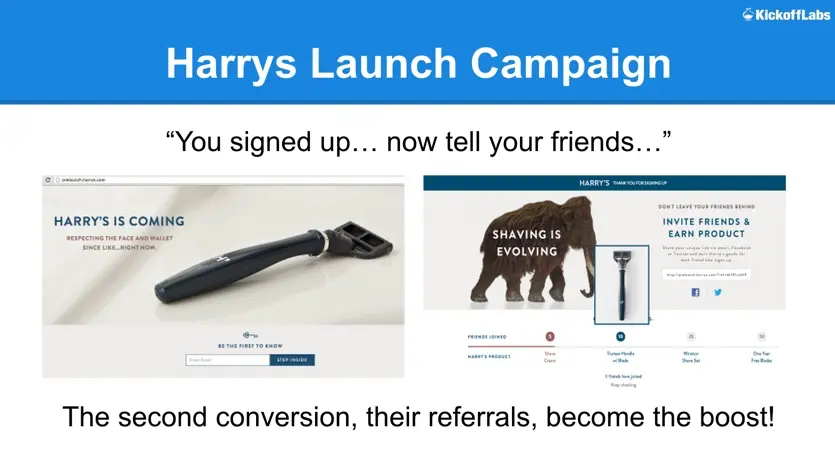
Another great example? The RobinHood.IO campaign:
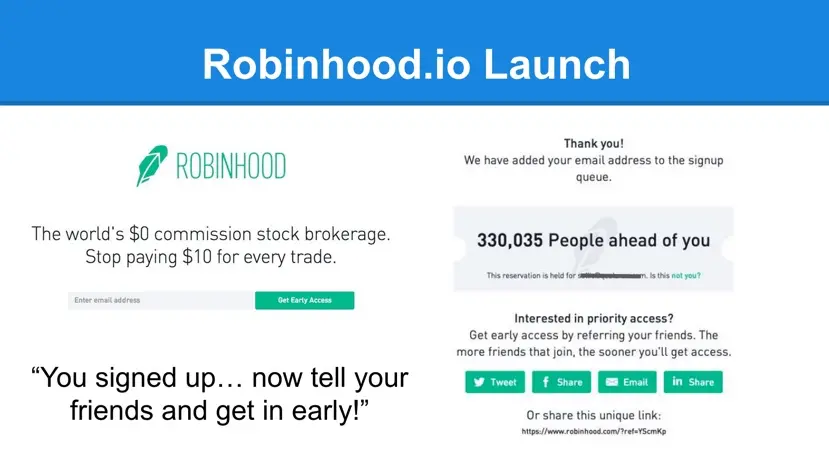
Ok – How do I get a viral boost with social referrals for MY campaign?
You could start by following these best practices we’ve learned from our 40,000 customers and analyzing their top performing campaigns.
1. Have an initial conversion rate better than 15%.
Pure conversion rate optimization is not the focus of this post, but you want to make sure you are converting a good chunk of the initial traffic you get to your landing pages. Otherwise you are choking the effectiveness out of any effort you put into the viral part of your campaign. You are also throwing money away… but that’s not the topic of this post. :)
Making something more viral won’t suddenly take you from a 5% to a 50% conversion rate since most people won’t even get that far. Here are some great articles on nailing the basics so you have a good baseline conversion rate:
- 8 Hacks for building your audience
- 14 Sins making people bounce from your landing pages
- 10 Examples that teach you how to write remarkable landing page copy
- And, of course, we’ve done a whole series of landing page reviews that are packed with tips…
Short version… Have clear copy that simply explains the benefits of converting and offers some incentive for doing so right now.
People want to share things that:
- They clearly understand the value of.
- They think is cool. Since it will, in turn, make them look great for finding it first.
2. When someone signs up… say thank you and deliver the goods.
If you offered an incentive, and you should, then you should deliver the incentive to the person ASAP along with a thank you message. You are about to ask these folks to do something for you in step 3 so you want them to feel in debt to you a bit. They won’t feel that way if they sign up and you turn around and say “oh… could you also”.
But if the approach is… “Oh – thanks for signing up. Here is the download you wanted… We know you’ll love it so why don’t you…”.
3. Ask the engaged customers to share what they’ve found right away.
Immediately after the thank you message you should display a simple, and obvious, second call to action… to share what they’ve just found with their friends and colleagues.
You want to do this on the thank you experience because you’ve got them hooked at this moment. You just got them interested in what you are doing. You just delivered them some value. This is the moment to ask them to share what they’ve found. You should also send this request in the thank you email.
It should be as easy as clicking a button from them to share because you’ll have the sharing buttons pre-configured for them to share a specific message for you. :)
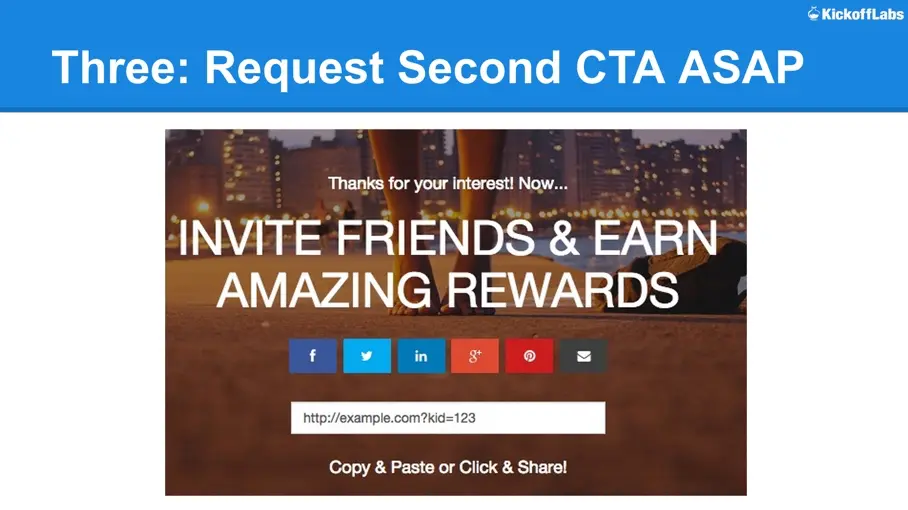
4. Drop the share request to their email as well…
This example, from Robinhood.io, was simple and to the point. I would have included some easy to use buttons instead of a link they had to cut and paste… but you get the idea.
5. Offer customers amazing incentives for sharing.
No one tells other people about your business out of the goodness of their hearts. We all want to believe that what we’ve built is simply that amazing. In reality you need to properly motivate people to take meaningful action even if you’ve got an amazing product offer. Your incentives need to be:
A. Achievable
The person has to believe it’s possible for them to accomplish. If, for example, you say that you’ll give them an award for referring 50 friends it won’t feel very achievable. Remember that the majority of people that generate a referral will generate between 1-3. It’s a dramatic drop off from the couple of people that will share and get 20+ referrals.
I don’t personally have 50 friends I feel like I could convince to do any one thing in a short amount of time. But I do have 3 or 4 people I know that might be interested in what you are offering. What could you do for people at that level?
B. Worth it
So… you want me to spam my friends, get 10 of them to signup, and you are going to offer me a $5 off coupon? No thanks. That’s simply not an offer that’s worth it for anyone you want as a customer.
Now… tell me that for 3 friends I’ll get 10% off and at 10 referrals you’ll give me 3 free months of your service… now you’re talking.
Here are two examples that felt achievable and worthwhile for perspective customers:
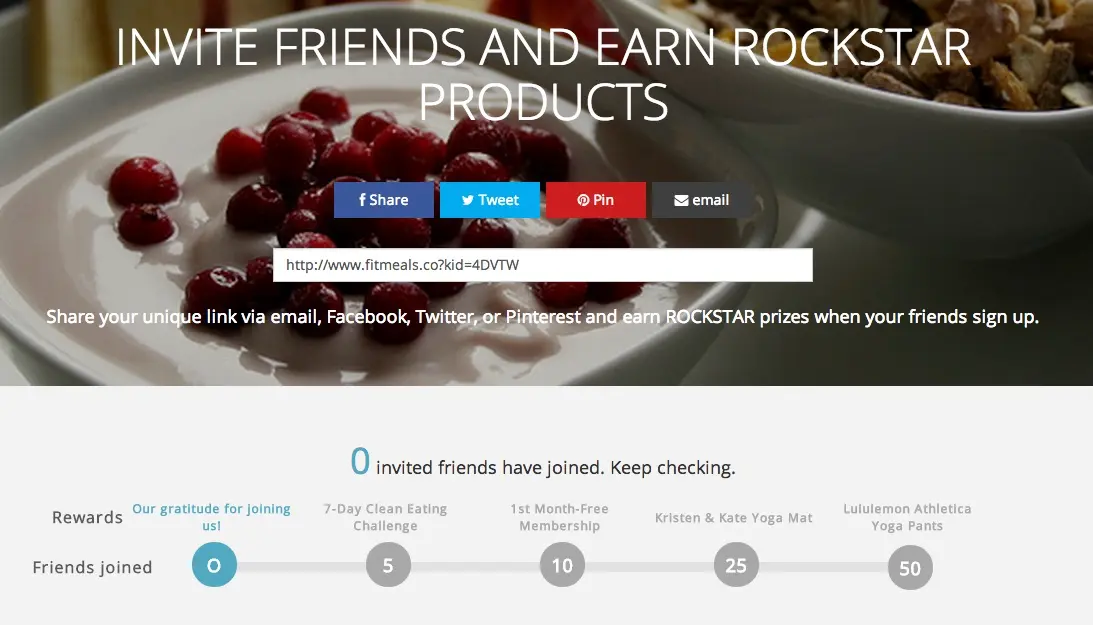
In this example ‘Level 0’ reinforces the thank you. ‘Level 5’ exists as a free informational product they will deliver to you. 10 referral get’s you a free month of membership… etc. It scales up nicely in a way that feels achievable at each step.
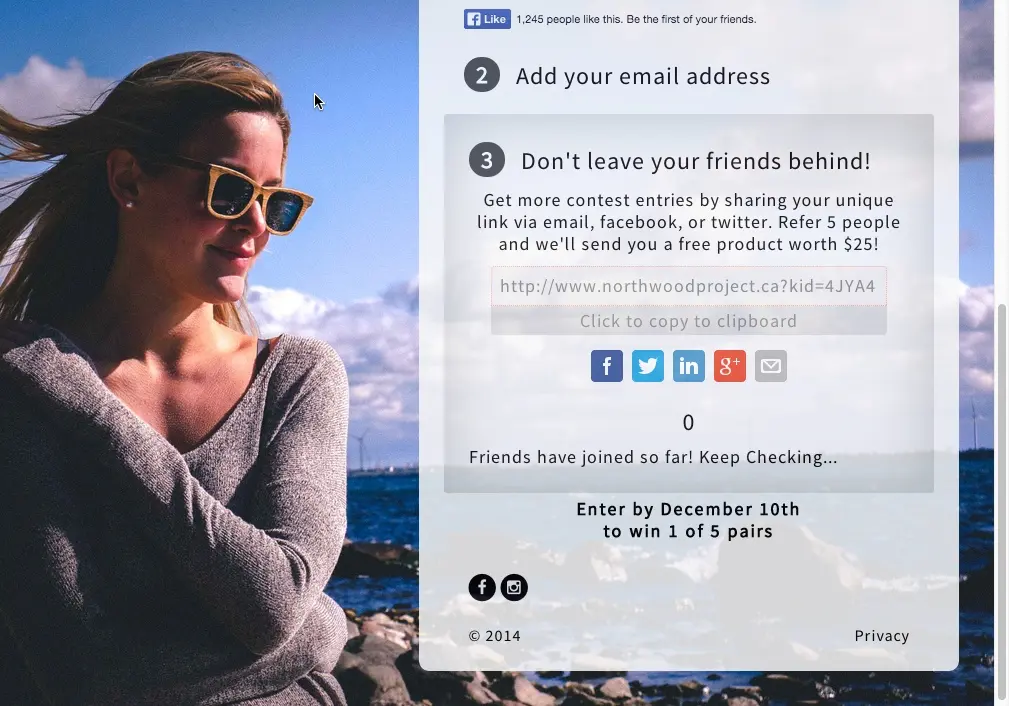
Simple and effective… get 5 people signed up and we’ll send you free product! The reward scheme doesn’t have to be complex to work.
Here are some template examples to get you thinking:
- Sign up 5 friends and get… (something for free)
- Most referrals wins… (contests for BIG prizes do get people motivated)
- Prize levels at 3, 5, 10, 50… (achievable and scaled for influencers)
- Get 3 and you are in… (to the beta)
- Move up in line… (get earlier access)
6. Follow-up with influencers via email.
There is a myth that says people will keep coming back to your landing pages in order to check their status. They won’t. The only one that obsesses about your campaign every day is you. For everyone else… send them gentle thank you notes and reminders via email.
When someone generates 1 or more referrals in a 24 hour period… you should send them an email that thanks them, delivers any rewards, and encourages them to share more. For example:
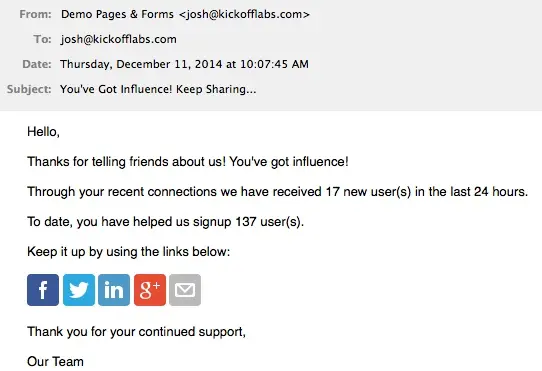
This is an example of the “Influencer Mail” that KickoffLabs automatically sends whenever a person has successfully gotten friends to sign up. We find this email to be an effective way of encouraging people to keep sharing. It makes them feel good about what they did and encourages them to keep going. This is the same philosophy discussed earlier… take someone that demonstrated engagement and get more out of them.
For people that share a lot (like the example above) I recommend taking the time to personally send them a thank you mail. That will do wonders for your PR and their determination to keep sharing. :)
7. Don’t forget about your existing audience and people that haven’t shared yet.
Someone entered your contest that ends next month and hasn’t shared yet… why would you give up on them? Same story for your launch campaign. The worst thing you could do is collect an email address, wait six months, and then send them some grand launch email.
You should be keeping them updated every 2-4 weeks. Let them know how things are going, deliver some value, and encourage them to start sharing because you’ve made it worthwhile to do so.
Yes – some people may unsubscribe from your campaign. You don’t want them there anyway. You want to find the people, throughout your campaign, that are the most engaged and get them acting on your behalf. And if your emails are providing value along the way in the form of advice, inspiration, entertainment, sneak peaks, etc… most people will NOT subscribe.
Remember…
When people hear about “viral growth” they have the impression that it has to be a hockey stick (meaning every person who signs up brings in two more people). They think they failed if that’s not the case. The hockey stick makes for a great story. A good unicorn that comes along every once in a while. For everyone else, adding virality is a tool to improve our odds and increase our conversion rates.
If you were given the choice between running an A/B test giving you results that were 10% more effective or adding a viral boost to gain a 27% boost (as seen above) which do you think is more worthwhile? Which should you choose? I think it’s obvious.
Everyone could use a viral boost.
You can also check out the slides here:
Using Social Referrals to Supercharge Your Landing Page Conversion Rate </strong> from KickoffLabs_Marketing
BTW – All of the mechanics in this post are things that we do “out of the box” with KickoffLabs. We’ve made adding a viral boost to any campaign very simple. Why not sign up today and check it out.
